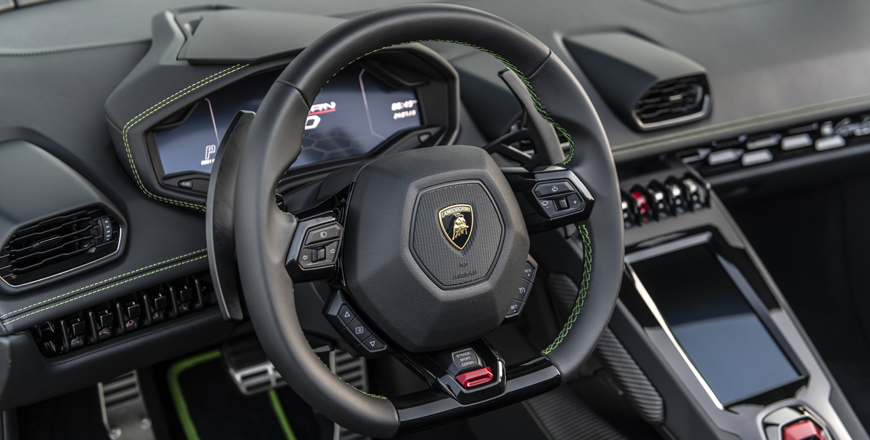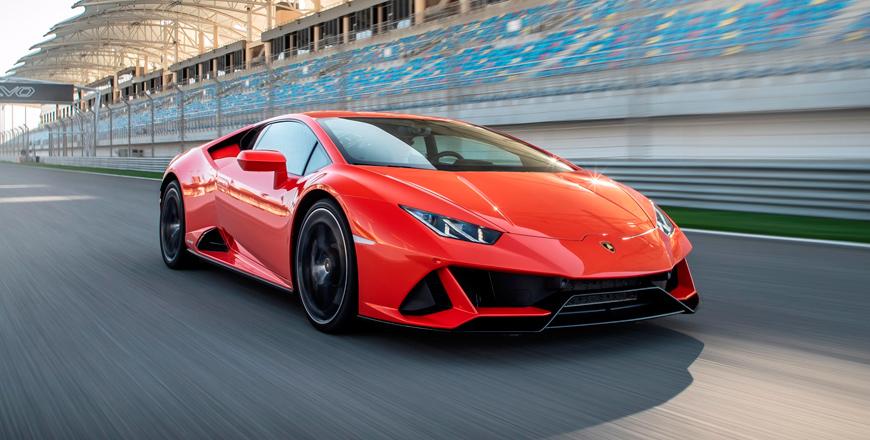You are here
Lamborghini Huracan Evo Spyder LP640-4: Last Hurrah
By Ghaith Madadha - Feb 19,2024 - Last updated at Feb 19,2024

Photos courtesy of Lamborghini

Historically playing second fiddle to Lamborghini’s glamorous V12 supercars, the Italian carmaker’s 1972-88 Urraco, Silhouette and Jalpa V8 sports cars lived in the shadow of the iconic and Miura and Countach.
Underperforming the V12 models’ sales despite being more attainable, the entry-level Lamborghini was retired until the 2003 Gallardo.
Launched as V10-powered junior supercar, the Gallardo proved to be a success and was succeeded and improved upon by the 2014 Huracan.
Now in its twilight, the Huracan conversely stands as the best Lamborghini on offer.
Perfected with the 2019 face-lift, the revised and redesignated Huracan Evo heralded a punchy performance boost, subtle styling refresh, improved tech and infotainment, better aerodynamics, and the transformative advent of four-wheel-steering coupled with better integrated electronic driving dynamic systems.
A purer, more visceral and engaging drive than its overweight and arguably diluted turbocharged Urus SUV and hybrid Revuelto supercar sisters, the Huracan line has most recently added three last hurrah models including track-focused STO and road-going Tecnica rear-wheel-drive versions, and a higher-riding off-road oriented Sterrato four-wheel-drive variant.
High rev thrills
With the standard Evo Coupe already axed, the Evo Spyder may live on borrowed time, but still looks and drives as fresh as ever.
Gorgeously low-slung with a jutting design, the Evo Spyder evokes a similar sense of urgency and momentum as the Coupe, while top-down mode flying buttress-like fins flowingly integrating its high-set rear deck and muscular haunches.
Incorporating lessons gleaned from the pre-facelift Huracan Performante, the Evo incorporates features fixed underbody airflow management and a slotted, raised and integrated rear spoiler for improved down-force aerodynamic efficiency.
Aesthetically exuding a heightened sense of drama with its triangular cooling ducts and side intakes, the Hurcan Evo’s sublime naturally-aspirated dry sump 5.2-litre V10 engine is meanwhile similarly improved in the form of a 30BHP power hike to match the outgoing Performante variant.
Producing 631BHP at 8,000rpm and 442lb/ft torque at 6,500rpm, the Huracan Evo’s scintillatingly high revving engine is urgently progressive, with a seamless sweep, and nerve-tingling medley of mechanical staccato, resonant metallic snarls, and wailing high-rev howl to redline, complemented by finger-snap throttle lift-off response.
Quick and committed
Rocketing through 0-200km/h in 9.3-seconds and onto a 325km/h maximum, the Evo Spyder is meanwhile just 0.2-second slower through 0-100km/h in 3.1 seconds than its 120kg lighter Coupe sister. Though high-strung, the Evo nevertheless delivers superb low-end response and mid-range muscle, with 70 per cent of its torque available from just 1,000rpm.
Swift and slick shifting, the Evo’s 7-speed dual-clutch automated gearbox features different settings for escalating response levels, and fixed column-mounted manual mode paddle-shifters. Massive ventilated and perforated discs meanwhile provide tirelessly effective braking including 32.2 metre 100-0km/h stopping power.
A comparative lightweight at 1,542kg, the aluminium-built Evo is equipped with a new generation central processing vehicle dynamic system that monitors, predicts and fluently adjusts adaptive dampers, four-wheel-drive, torque vectoring and traction control settings for different dynamic attitudes, and can even direct traction to one wheel.
Tidy, balanced and firmly poised through switchbacks, the Evo’s slight rear weight and power bias allow for agility, adjustability and commitment as needed.
Huge 305/30R20 rear tires meanwhile grip hard as its four-wheel-drive provides tenacious traction, and alters rear-to-front power distribution, as necessary.
Agility and stability
Viscerally thrilling with its immediate responses and immersive connectedness, the Evo is sure-footed yet nimble, with a limited slip rear differential allocating power side-to-side for stability and agility, and is complemented by brake-based torque vectoring.
Adopting four-wheel-steering, the Evo meanwhile makes significant agility and stability improvements.
With front wheels turning opposite to rear at low speed and in the same direction at higher speed, four-wheel-steering effectively shortens or lengthens its wheelbase. Providing sharp turn-in immediacy and near telepathic directional change reflexes, it also enhances lane change stability at speed.
Settled and buttoned down at speed and in vertical movements, the Evo Spyder is comfortable for a convertible supercar.
Well-insulated with fabric roof up, it meanwhile folds down electrically in 17-seconds. With little wind buffeting with top down, the Evo’s driving position is ergonomic and supportive, with good front visibility and intuitive easy reach controls.
Swathed with Alcantara and leather, the Evo is meanwhile well-equipped with an improved infotainment system with an 8.4-inch vertical touchscreen and enhanced connectivity and voice activation, in addition to various safety and convenience systems.
- Engine: 5.2-litre, mid-mounted, dry sump, V10-cylinders
- Bore x stroke: 84.5 x 92.8mm
- Compression ratio: 12.7:1
- Valve-train: 40-valve, DOHC, direct injection
- Gearbox: 7-speed automated dual clutch
- Driveline: Four-wheel-drive, mechanical self-locking rear differential
- Power, BHP (PS) [kW]: 631 (640) [470] @8,000rpm
- Specific power: 121.3BHP/litre
- Power-to-weight: 409.2BHP/tonne
- Torque, lb/ft (Nm): 442 (600) @6,500rpm
- Specific torque: 115.3Nm/litre
- Torque-to-weight: 389.1Nm/tonne
- 0-100km/h: 3.1-seconds
- 0-200km/h: 9.3-seconds
- Top speed: 325km/h
- Fuel consumption, combined: 14.2-litres/100km
- Fuel capacity: 83-litres
- Length: 4,520mm
- Width: 1,933mm
- Height: 1,180mm
- Wheelbase: 2,620mm
- Track, F/R: 1,668 / 1,620mm
- Dry weight: 1,542kg
- Weight distribution, F/R: 43 per cent / 57 per cent
- Luggage volume: 100-litres
- Steering: Electric-assisted rack & pinion, all-wheel steering
- Turning circle: 10.9-meters
- Suspension: Double wishbones, optional adaptive magnetic dampers
- Brakes, F/R: Ventilated, perforated carbon-ceramic discs 380mm / 356mm
- Brake calipers, F/R: 6-/4-piston calipers
- Braking distance, 100-0km/h: 32.2-metres
- Tyres, F/R: 245/30R20 / 305/30R20
Related Articles
The refreshed ragtop version of the iconic Italian automaker’s “junior” supercar line, the Lamborghini Huracan Evo Spyder’s revisions go bey
Winner of the 2020 Middle East Car of the Year’s Best Performance Coupe prize and runner up for the top award, the Lamborghini Huracan Evo f
With no shortage of desirable, fast and viscerally styled cars to its name since it was founded in 1963, the recently launched Lamborghini H



















